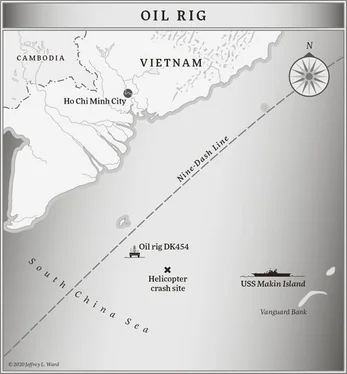“Thank you, sir!”
Tian stepped away. “But if we are to do this, then we should do it without delay. I am sorry that there is no more time for you to prepare.”
“I assure you, Captain,” Commander Wan said, “I would rather not linger. I was prepared from the moment I wrote my name on the papers.”
The PLAN Submariner Academy in Qingdao ran every student through egress exercises. Wan still remembered his experience putting on the full-face mask and “horse-collar” flotation aid before crawling into the modified torpedo tube and waiting for it to flood. When the hammer clanged three times on the hatch, he opened the flooded tube and kick-floated his way through a few feet of slightly cool water to the surface, into the arms of waiting instructors who wore scuba equipment to save him if he got into trouble.
This was not going to be like that.
The ungainly orange suit was a Chinese copy of the Submarine Escape Immersion Equipment, or SEIE, suit, designed and manufactured by RFD Beaufort Limited and utilized by, among others, the U.S. Navy. The operation was relatively straightforward. He would enter the lockout trunk wearing his suit, and attach the tube from his suit to an air connection that, when the time came, would fill the enclosed hood and provide him with flotation and breathing air on the way to the surface. The function of the trunk was exactly the same as that of the training tube in Qingdao, with the exception that this one was much larger, to accommodate several Special Forces divers, should the need arise. There were no Special Forces divers on this trip, or one of them would have had this honor.
Because of the unpredictability of the ice after it was broken—if it broke at all—it was decided that Commander Wan would enter the lockout trunk and flooding would begin as the Yu-6 torpedo was fired. Coordinates were plotted and the 880 ’s fire control guided the fish via its trailing wire umbilical, sending it as close to straight above their heads as possible.
Sweating profusely in the waterproof suit, Wan opened the escape trunk’s inner hatch. He saluted the crew, who had crowded into the forward torpedo room, and then hung the rubber pack containing the satellite phone around his neck, clipping it to a belt around his waist to keep it from becoming an entanglement hazard.
Captain Tian stepped forward, gave him another pack with a short shotgun inside.
“The chief sawed off the barrel, to make it easier for you to carry.” The captain pursed his lips again, patting Wan on the shoulder. “I would hate for you to see a polar bear.”
At that, the captain nodded to the assistant medic, who’d had little training but for what he got on the job. He carried a long steel needle. “The medical manual suggests submariners egressing from depths perforate their eardrums prior to leaving, to avoid a more violent tear during rapid ascent.”
“Very well,” Wan said. He did not know if puncturing an eardrum would hurt, but he thought having one ripped apart by pressure might render him incapable of making the decisions he would need to make at the surface. He pushed the SEIE suit’s hood back to expose his ears. “Please go ahead.”
“Me?” the seaman stammered. “I had thought …” He held up the needle with an unsteady hand.
Wan smiled, rescuing the young man by taking the needle from him and deftly popping both his own eardrums, quickly, one after the other, before he had time to think. It smarted, but, to his surprise, it was not excruciating, and he could still hear.
He returned the needle and entered the escape trunk. The heavy door closed behind him with a resounding metallic thunk , muffling the sound of the cheers coming from the crew.
Almost immediately, seawater began to flow in around his feet, filling the metal box, the rising pressure causing the holes in his eardrums to hum.
He did not hurt—yet.
31
Captain Cole Condiff, skipper of the Virginia -class fast attack submarine USS Indiana (SSN 789), stood in the control room, behind the officer of the deck. They were three hundred feet under the Arctic ice, eight hundred miles south of the North Pole, approaching the point where the Beaufort Sea became the Chukchi.
A second U.S. sub, the Seawolf -class USS Connecticut , had departed the latest ICEX the week before, but Condiff had held his boat back, running drills, waiting. Russian subs were well aware of the U.S. Navy’s biennial Arctic combat and tactical readiness exercise. There had been nearly fifty personnel at the camp above the ice for almost three weeks. The Russians did the same kind of training, maybe even more, if you considered the proximity of their sub bases to large sheets of ice. The Chinese were throwing up ice camps, too, attempting to show some polar connection. Their subs were also here, or so he’d heard, charting, learning.
With new shipping lanes and trade routes coming into play as the ice opened up more and more each year, every nation with a toehold in the Arctic worked to make sure they had the right tools to navigate and protect their interests. If the Russians knew about ICEX, then they would be lurking, waiting on the fringes for the U.S. subs to go home.
Captain Condiff’s predatory drive kicked in at the thought, and he’d decided to let the Connecticut draw away any lurkers, and then he would fall in behind, hunting his way home.
Indiana had been under the ice for six days—since they’d said good-bye to their friends at the ice camp. Thick floe and huge daggerlike ice keels prevented deployment of the ELF antenna, making communication with the outside world impossible. Condiff expected open water by the end of watch, where the ELF could pick up any traffic from command. Until then, his sonar technicians watched the wavering green waterfall on their screens for the sound signatures of a Russian submarine.
Condiff took a deep breath. He was long past smelling it, but knew there was an odor there that those on land found disquieting if not disgusting. His wife made him wash his uniforms three times as soon as he walked in the door after a deployment. Even then, she relegated them to designated plastic totes that stayed on a shelf in the garage until the next time he went to sea.
Reusable water bottle in one hand, the skipper chatted with one of the newest members of his crew, a twentysomething woman named Ramirez. A freckled farm-boy lieutenant from Nebraska named Lowdermilk was officer of the deck at the moment, leaving Condiff to conduct his training. Unlike older submarines, Virginia -class subs like Indiana had consolidated the watch positions of dive, helm, outboard, and chief of the watch into pilot and copilot who both sat at a console in front of the officer of the deck, who gave them maneuvering orders. Combat control consoles ran along the starboard side. Sonar technicians sat at consoles to port, opposite combat control.
Along with approximately ten percent of her crewmates, this was Ramirez’s first tour. Participation in ICEX was a surprise bonus for these newbies, since Blue Noses, submariners who’d crossed the Arctic Circle, were relatively rare. It was one of the few missions a young submariner could brag about while ashore without getting into trouble.
Ramirez was taciturn, a quality Condiff liked if he did not share. Even better, she was a quick study. Her formal training was to be a sonar tech, or STS. Captain Condiff had no doubt that she would eventually become an outstanding one, but before that, he liked to have his newbies take a tour through the specialties, sonar, combat control, engineering, communications, among others, even the galley. Everyone on the sub drilled in emergency procedures, so she got plenty of that as well. Not only had these few weeks of round-the-boat training taught her a little about most of the systems, she’d been able to see firsthand how components of the crew acted and interacted. The rest of the crew also got to know Ramirez and her fellow newbies.
Читать дальше











![Александр Ирвин - Tom Clancy’s The Division 2. Фальшивый рассвет [litres]](/books/417744/aleksandr-irvin-tom-clancy-s-the-division-2-falsh-thumb.webp)
